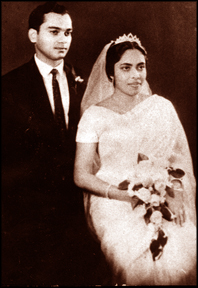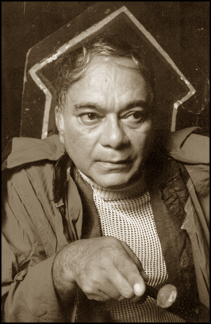|
Glimpse into the life and times of Henry Jayasena:
Azdak of Sinhala theatre leaves the stage
by Indeewara THILAKARATHNE
 |
|
Henry Jayasena, Manel
and their son Sudaraka |
 |
|
Henry Jayasena and Manel on their
wedding day |
"For some of us who have been around from the very beginning, 25
years ago, such as Manel (Henry's wife), Warakagoda, Santin, Gunie,
Nimal, Yasie, Fitzrony, Chula Piysekara and H.L.P and myself. It has
been a part of our very lives and I am sure each of us will have many
moments of joy, sorrow and anxiety to remember ..." Henry Jayasena on
the 25th years of staging his brilliant adaptation of Bertolt Brecht's
Caucasian Chalk Circle or 'Hunuwataye Kathawa'.
Perhaps, 'Hunuwataye Kathawa' and his immortal role as Azdak not only
marked an important milestone in the trailblazing career of Henry
Jayasena who breathed his last after a brief illness but also marked a
watershed in the Sinhala theatre. Henry Jayasena represented a vanishing
tribe of bilinguals who had been evolved in the 1950s and 1970s under
the overarching influence of the Peradeniya School. In fact, his first
ever appearance on the stage was at the Open Air Theatre of the
University of Peradeniya, in Prof. Ediriweera Sarachchandra's 'Maname'
as the Prince of 'Maname.
Although his earlier plays such as 'Pavu karayo' which was produced
in 1959 met with brickbats, subsequent productions such as 'Kuveni'
(1963), 'Hunuwataye Kathawa' (1969), 'Tawath Udesanak', 'Apata Puthe
Magak Nethe' (1968), 'Diriya Mawa saha age daruwo' (1972), 'Makara'
(1974) 'Sarana Piyaapthse Puthuni Hamba yana' (1975) and 'Sirisangabo'
(1978) earned a name for him and established himself as a major
dramatist in Sinhala theatre. Apart from being a master producer of
drama and actor, Henry Jayasena was a multi-faceted personality who had
proved his mettle in diverse fields such as cinema and television as an
actor. He was also brilliant as a bi-lingual writer.
One of his memorable roles in cinema was as Piyal in Dr. Lester
James's 'Gamperaliya' which was recently restored and released in France
as a commercial film. Henry himself considered his role as Piyal was one
of the best performances in cinema. On Henry Jayasena's acting in 'Gamperaliya',
Dr. Lester James Peries stated in "Lester by Lester as told to Kumar de
Silva", "Even Henry Jayasena had hardly acted before and was thinking in
terms of the stage. As he said, he had acted in one commercial film when
he came for Gamperaliya and was thus relatively unspoiled. This is not
making any reflection on his subsequent career, but his performance in 'Gamperaliya'
was so subtle and so quite that even he himself thought that he was
better in other films where I personally think he was over acting".
Among films he rendered his talents were 'Gahanu Gata', "Sri 296", "Sohoyuro",
"Heta Pramada Vadei", "Wena Swargayak Kumatada" and "Sigiri Kashapa".
 As all good writers are good readers, Henry Jayasena was a voracious
reader who read books both in Sinhala and English. He was a writer who
could only write if he had an impulse to do so. For instance, some of
his dramas such as "Thawath Udasanak" were born out of a personal
experience. The drama was based on a calf named Rabbada Aiyya. Henry was
fond of the calf. However, when moved following the Second World War,
Henry had to abandon the calf which subsequently he learnt died having
fallen into an abandoned well. He wrote his autobiography entitled "Karaliyaka
Kathawak" and "Nim Neti Kathawak" which was a sequel to the "Minisun Vu
Daruwo" which was written in the 60s. As all good writers are good readers, Henry Jayasena was a voracious
reader who read books both in Sinhala and English. He was a writer who
could only write if he had an impulse to do so. For instance, some of
his dramas such as "Thawath Udasanak" were born out of a personal
experience. The drama was based on a calf named Rabbada Aiyya. Henry was
fond of the calf. However, when moved following the Second World War,
Henry had to abandon the calf which subsequently he learnt died having
fallen into an abandoned well. He wrote his autobiography entitled "Karaliyaka
Kathawak" and "Nim Neti Kathawak" which was a sequel to the "Minisun Vu
Daruwo" which was written in the 60s.
Henry Janasena's larger than life shadow cast on the Sinhala theatre
will remain as an enduring influence in years to come. However, his
singular role as a master producer of drama and as a bilingual who
brilliantly adapted several dramas including Caucasian Chalk Circle into
Sinhala which stand the test of time owing to its rich language and
metaphor should be judged against the backdrop of contemporary Sinhala
theatre. The rich tradition of translations and adaptation in Sinhala
theatre to which Henry Jayasena contributed to a great extent, is,
unfortunately dying due to the dearth of competent translators.
Given the poor quality of most of the translations in Sinhala, it is
highly unlikely masterpieces such as 'Hunuwataye Kathawa' and 'Diriya
mawa ha age daruwo', would ever emerge from contemporary Sinhala
theatre. For instance 'Hunuwataye Kathawa' which was one time prescribed
text for Advanced Level Sinhala is one of the masterpieces in Sinhala
theatre albeit it is an adaptation. It is so rich and so aptly adapted
into Sinhala that Grusha, the female lead in the play, the role
continuously played by Henry Jayasena's wife Manel and Azdak which Henry
Jayasena played over the years remain as major characters in Sinhala
theatre. His play such as 'Diriya mawa ha age daruwo' which is the
adaptation of Bertolt Brecht's "Mother Courage" has been and is still
being a popular drama which captured the quintessential turbulent
atmosphere of a war ravaged country.
|

